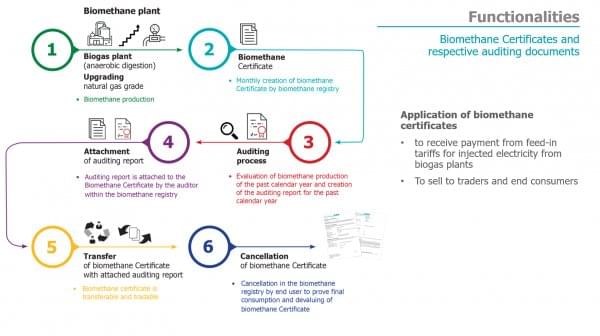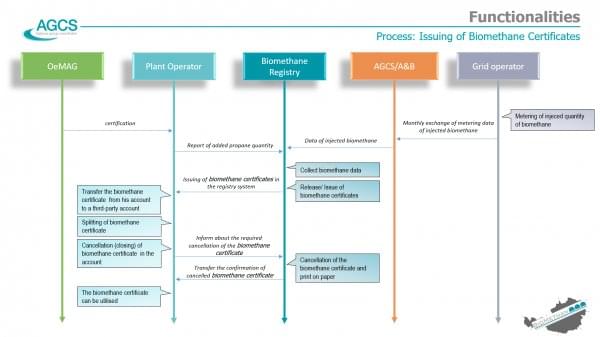Audits
Quality assurance through multi-stage assessment system
In the course of the issuance of biomethane certificates by the registry operator, each individual certificate is subject to a plausibility and quality check by the registry operator at the time of issuance in accordance with the market participants' documents submitted to the Biomethae Register Austria and the injection data provided by the network operators.
In addition, each market participant is free to have its biomethane product and the respective certificates verified separately by an external auditor. As part of the registration process, the biomethane plant operator has to nominate the respective auditor who will then be granted access to the certificates of the respective biomethane plant by the registry operator.
Registered auditors can view certificates from biomethane plants assigned to them directly in the registry and confirm its origin and quality by means of a corresponding auditing report or auditor annotation. Corresponding, each auditor in the registry is free to upload the auditing reports directly to the registry system, where it is assigned to the respective certificate and can be viewed by the certificate owner. The information added by an auditor remains in the certificate, even after ownership transfer or splitting of partial energy amounts to create a daughter certificate.
National subsidy for power generation plants using biomethane (FiT, Ökostromförderung)
In order to obtain subsidies in the sense of the Green Power Act 2012 (Ökostromgesetz, ÖSG), biomethane certificates must be audited by independent auditors. More detailed information on this can be found in the Green Electricity Act 2012. The following figures depict the process steps for obtaining green electricity support. The Biomethan Register Austria and the Austrian Green Power Settlement Agency (OeMAG Abwicklungsstelle für Ökostrom AG) are always available during office hours to assist you with any questions or comments.


Proof of sustainability criteria
Sustainability criteria are defined according to Art 25-31 of Directive (EU) 2018/2001.
The allocation of energy amounts from renewable gas to the Union targets (Art 3) according to the requirements of Directive (EU) 2018/2001 (Renewable Energy Directive II) are based in particular on the sustainability requirements (Art 25-31) for renewable energy sources such as biomethane. While renewable electricity is calculated with zero emissions, in particular wind and photovoltaics, this is not the case for renewable gases, because emissions are basically generated in the production process, for example during the transport of the raw material to the production plant. These must be documented in detail and verified by an external third party (expert).
The proof of compliance with “sustainability criteria” according to Art 25-31 (in particular Art 29-31) of Directive (EU) 2018/2001 follows a system which may only be applied after recognition by the EU Commission as a "voluntary scheme". Sustainability criteria are based on a calculation of CO2-equivalent emissions along the entire chain of custody of the product. This greenhouse gas emission value must be below the corresponding fossil reference value (see Art 29 of Directive (EU) 2018/2001, in particular Para. 10 Item d) of the respective area of application to demonstrate sustainability.
An assessed amount of energy is only considered to have been produced sustainably if it is shown to be below the reference value. The reference values differ according to application areas, such as the heating sector and the transport sector. The reference value for the heating sector is significantly lower than, for example, the reference value for the transport sector, because of the reference to diesel and gasoline.
The calculation of this greenhouse gas emission value follows an assessment of raw materials used, transport distances travelled, and production processes applied, and is often calculated based on on-site visits by the auditor. The unit of the greenhouse gas emission value is given in grams of CO2eq per MJ of the energy carrier. The statement as to whether the energy amount of an energy carrier has fulfilled the corresponding sustainability criteria - whether the reference value of the corresponding application sector has been undercut - can only be made at the point of closing the mass balance, i.e. when the application sector becomes aware of the final consumption of the corresponding energy quantity.
To demonstrate sustainability, a corresponding sustainability certificate (Proof of Sustainability) is issued according to a “voluntary scheme” by a respective certified auditor. The Biomethan Register Austria makes it possible to state the sustainability criteria in the biomethane certificate and to attach the Proof of Sustainability to the biomethane certificate.